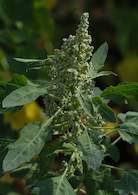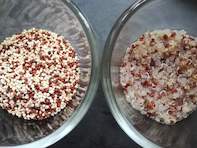
Quinoa (Chenopodium quinoa Willd) - pronounced as ‘keen-wah’ - is a ‘forgotten grain’, estimated to have been grown for at least 5 000 years on high plateaus and desert regions of the Andean Mountain chain stretching over the length of the South American continent.
Referring to quinoa as an ‘ancient grain’ might be a misnomer since crops such as wheat and rice have also been cultivated for thousands of years.
Quinoa is also classified as a ‘pseudo-grain’ because technically it is not a grain such as the types normally harvested from plants in the grass family (e.g. rice and wheat). It rather grows on broad-leaved plants and is related to spinach and beet. Quinoa bears its seed in plume-like inflorescences referred to as panicles.
The rapid increase in the popularity and demand for this forgotten grain was due to it being declared as the 'International Crop of the Year' in 2013 by the United Nations.
It was in recognition of ancestral practices of the Andean people, who have managed to preserve this ancient crop. It is now grown throughout most temperate and high altitude regions of the world.
In contrast to grains such as wheat and rye, quinoa is gluten-free and very high in protein (12-16.5%) compared to rice (7.6%) and maize (10.2%).
Coupled with its high nutrient value, quinoa is recognised as a crop that can address chronic global malnourishment. Quinoa plants have excellent adaptability to drought and cold and may also be cultivated in marginal soils that include saline and pH disturbed areas.
Raw quinoa contains a bitter-tasting compound, saponin. (Saponin is also present in chickpeas, spinach, red kidney beans etc.)
The seeds’ coating has to be processed - either by rinsing in water (before cooking) or through mechanical peeling by friction (done in processing factories) - to ensure better taste.
Benefits and Uses of Quinoa

Protein-rich quinoa can be sold in a diverse range of products, which may include quinoa flakes, flour and ready-to-use food products such as biscuits. It is also enjoyed as an unprocessed whole grain.
Quinoa is often steam-cooked and rolled into flakes to produce a quick-cooking hot cereal. Quinoa flour (slightly coarse, almost resembling maize meal) has a higher plant fat content than wheat and, when used in baked products, results in a moister end product.
Quinoa is sold most commonly as a whole grain product, and most commonly as an ivory-white type in South Africa. Red, black and pale-yellow quinoa is also available and more often available internationally.
Although there are more than 120 known varieties of quinoa, white and yellow quinoa is the most common. It has the mildest flavour and tends to cook faster, but more ‘mushy’. Red and black quinoa have stronger, earthier flavours and tend to hold their shape better than lighter coloured quinoa. Black quinoa takes the longest to cook.
Before cooking, rinse the grains to remove any leftover bitter-tasting saponins (found externally on quinoa seed). Cook until a little ‘tail’ appears. This is the external germ, which forms a band around each grain and loosens when the grain is fully cooked. Quinoa is cooked unlike rice; with a ratio of two parts liquid to one part dry quinoa.
Quinoa can also be cooked in milk for a porridge, used in the place of pasta in salads, replace the rice in sushi, and popped and consumed as ‘popcorn’.
Nutrients in Quinoa
Quinoa is gluten-free and a high-quality ‘plant-based protein’ suitable for vegans. It contains all nine essential amino acids, the building blocks of protein. This includes the amino acid lysine, vital for growth, development, energy production in muscles and necessary for the synthesis of many proteins.
Quinoa’s fat content (2 - 10%) has high concentrations of polyunsaturated essential fatty acids, including omega-6 and omega-3. It is higher in fat (6.3%) than maize (4.7%) and wheat (2.3%).
Quinoa meets the requirements set for most vitamins, more so than any other grain. It specifically provides high levels of riboflavin and vitamin E as well as higher levels of vitamin C and ß-carotene (vitamin A) than found in rice, barley and wheat. Quinoa may also be considered a good source of minerals because it contains iron, magnesium, potassium and zinc and is also a good source of dietary fibre.
Brasilian studies found quinoa to be especially rich in an antioxidant called quercetin which may be beneficial in managing type-2 diabetes and associated high blood pressure.
By Marinda Louw